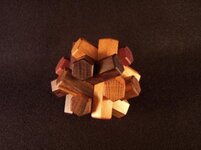devowoodworking
Member
Just wondering if any of you casting guys can answer my question, my latest puzzle uses 3/4" hex stock and I started to think it might be cool to use some 'Alumilite' in solid colors...if anyone is interested in following up on this theme send me a PM and I can give you more specifics, here's a pic of the finished puzzle in four woods; Wenge/Lacewood/Purpleheart/Benge
I also added a pic of what the pieces with notches look like, piece length is 3"
I also added a pic of what the pieces with notches look like, piece length is 3"


